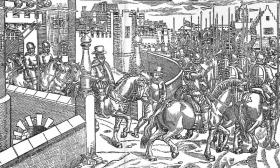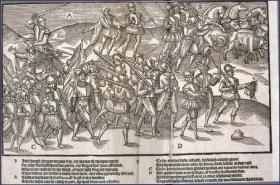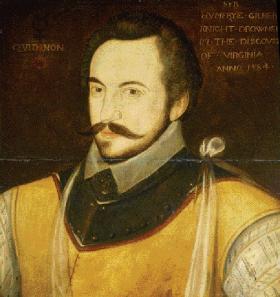‘Some days two heads and some days four’
Published in Early Modern History (1500–1700), Features, Gaelic Ireland, Issue 1 (Jan/Feb 2009), Volume 17
Sir Henry Sidney riding out from Dublin Castle. Overlooking him, suspended on spikes over the main gate, are the ‘trunkless heddes’ of three bearded Irishmen killed on his orders. (John Derricke’s The Image of Irelande, 1581)
The following day they secured a reward for their endeavours from the commander of the English garrison at Lough Foyle, Sir Henry Dockwray. Presenting Tirlough’s head to him, they were given ‘a good sum of money’ and the promise of English government protection in the years to come. As soon as the money was disbursed they disappeared from the fort and from contemporary sources. Dockwray was invariably discreet in such ‘practices’: even years afterwards he kept the identity of the swordsmen secret.
Head money
his dark little tale provides a vivid depiction of the collecting of the reward or bounty known as ‘head money’, as it operated in Ireland late in the Tudor conquest. It can be found in Dockwray’s memoir of the Nine Years’ War in Ulster, A Narration of the Services done by the Army Ymployed to Lough-Foyle, under the leadinge of mee Sr Henry Docwra, knight, which Sir Henry wrote in the summer of 1614. While hardly the only record of the period to mention head money, it is almost unequalled in its telling of the whole story of a successful head-taking mission, from the initial planning through to the bloody act itself and the aftermath of rewarding the beheaders. It even describes the later treatment of the head. Thus we learn that, prior to the killing, Dockwray had summoned the four killers and other would-be bounty-hunters to a meeting at Lough Foyle to announce a reward for the capture of Tirlough and his followers, ‘deade or alive’. The gap between this meeting and the delivery of Tirlough’s head was four months, a delay that worried Dockwray: the longer Tirlough evaded capture, the greater his reputation among the native population. When finally Tirlough was slain and his head brought in, Dockwray seized the opportunity it afforded to raise the spirits of the garrison troops and to demonstrate his prowess as a prosecutor of England’s adversaries. Taking hold of the severed head, he made what he called ‘a ludibrious spectacle’ of it, having it displayed ‘to every boy in the [royal] army’. To cheers and laughter, the message was relayed that this was what happened to rebels in Sir Henry’s jurisdiction.
Horror and theatre have always been close companions. It was precisely for spectacle like this that ‘head money’ was deemed money well spent by the Tudor government in Ireland, and was offered routinely to anyone who helped the Crown eliminate its enemies. Decapitation had powerful symbolic value. The head was believed to be the repository of the personality and the soul. Its removal clearly demonstrated the defeat of an enemy; its misuse and ritual display marked his or her humiliation. To suffer such a fate was to be denied the most basic human dignity. It made proper burial impossible: in medieval/early modern times the true place of burial was where the head lay.

English soldiers return from battle in triumph, carrying the severed heads of their Irish enemies. (John Derricke’s The Image of Irelande, 1581)
Official spectacle
For almost 70 years, from the mid-1530s, the display of decapitation had become an increasingly common feature of the government’s growing presence around the country. As its garrison network pushed further into the localities, visitors to royal strongholds such as Athlone, Castlemaine or Leighlinbridge were often greeted by the sight of severed heads affixed to poles extending forbiddingly out from the walls as they approached.
But it was at the main seat of royal power, Dublin Castle, that the spectacle of the beheaded was most developed. Generally the heads of rebels that adorned the outlying forts belonged to small fry, to minor rebels, outlaws and cattle-thieves; it was only at Dublin that those of the principal rebels and ‘most notorious malefactors’ were displayed. There were practical reasons for this. The remoter garrison commanders were often without cash: consequently, bounty-hunters were inclined to travel straight to the state capital to deliver their grisly offerings to the viceroy in person and obtain their ‘head money’ direct from the royal treasury. Plainly, too, it made a harsh kind of sense that the monarchy’s greatest opponents had their annihilation exhibited at the epicentre of royal authority, as a symbol of the Crown’s growing power.
The Tudor viceroys took great pride in such grim evidence of their military supremacy. In John Derricke’s The Image of Irelande, an extravagant celebration of Sir Henry Sidney’s viceroyalty that was published in 1581, Sidney is depicted in a woodcut setting out from Dublin Castle on an expedition into the ‘wilde’ interior. Overlooking him as he rides across the castle bridge, suspended on spikes over the main gate, are the ‘trunkless heddes’ of three bearded Irishmen killed on his orders. Important political dividends sometimes followed such a display. In June 1586 the ageing Scots-Gaelic chieftain Sorley Boy MacDonnell was brought to Dublin Castle under protection to finalise a treaty of submission with Sir John Perrot. His son and intended successor, Alexander McSorley, had been killed and beheaded in Antrim just a few months earlier by the troops of Captain Nicholas Merriman. On the old lord’s arrival in the capital, he had to pass under the head of his son when entering Dublin Castle before the discussions began—an ordeal that made a calculated mockery of his ‘protection’ and broadcast the government position that the treaty he was to sign was a concession by the Crown, even an act of mercy.
Head-taking and ‘civility’
Readers will have noticed that while the first beheading described (of Tirlough Magnylson) was carried out by four Irishmen, the second (Alexander McSorley) was effected by Merriman’s English troops. Evidently, head-taking was a feature of warfare common to both Irish and English soldiers operating in Ireland at this time—an unremarkable observation, were it not that in Elizabethan drama, performed on the London stage, it was usually depicted as a uniquely Irish practice. In William Baldwin’s The Mirror for Magistrates (1559) the narrator described the Irish as exceptionally bloodthirsty, fighting purely for the pleasure of killing. They took no prisoners, not even for ransom, instead prizing ‘a deadman’s heade’ as the chief booty of war. Fifty years later John Webster embellished this image, having ‘the wild Irish’ selling heads like ordinary market produce and using them as footballs.
Recent research demonstrates that plays like these tended to confirm the popular English view of Ireland as a benighted, savage land. Equally significantly, however, they also served to underpin the official government line that only strong English rule would ‘civilise’ the country. Accordingly, the fact that viceregal propaganda such as Derricke’s Image of Irelande celebrated English soldiers decapitating Irishmen (and women) while playwrights denounced Irish head-takers as murderous barbarians was not as contradictory as it seems. Irish head-taking was deemed wrong and English head-taking right because the Irish were seen to do it uncontrollably, through sheer blood-lust, while the English in contrast did it to impose control, as part of their civilising mission to introduce the proper rule of law in Ireland. Moreover, to have theatre audiences reminded that the Irish sometimes removed English heads may have raised patriotic support for the sort of punitive military measures that the government intended to undertake.

Sir Humphrey Gilbert, colonel of Munster 1569–71, who ordered the decapitation of entire villages in order to have the path to his tent decorated with ‘a lane of heddes’ prior to inviting the submission of local chiefs and leaders. (NTPL)
Escalation under the Crown
Perhaps the most interesting thing about head-taking in Tudor Ireland is how it escalated following the government’s adoption of a policy of conquest and colonisation. From the late 1540s the wars fought by the Crown in Ireland (by a greatly enhanced royal army) required it to fight more intensively—and ruthlessly—than hitherto in order to seize control of the provinces. The fact that a proportion of the English soldiers who were recruited had earlier served on the Anglo-Scottish frontier ensured that the amount of beheadings in Ireland increased significantly (decapitation had been a feature of the Scottish border wars for centuries). Tudor treason laws, authorising decapitation as an appropriate penalty for rebels, were another contributory factor, especially as the Crown defined its Irish wars as essentially counter-insurgency operations. But just as influential was the deliberate employment of shock tactics by government army officers. Some of the worst atrocities committed in sixteenth-century Ireland occurred because certain English captains were determined to emulate the very worst aspects of native military behaviour, and surpass them. Take Sir Humphrey Gilbert, colonel of Munster 1569–71: he ordered the decapitation of entire villages in order to have the path to his tent decorated with ‘a lane of heddes’ prior to inviting the submission of local chiefs and leaders. Rather than conceal such antics, he exulted in them, having his exploits commemorated by the writer Thomas Churchyard as someone selflessly dedicated to a terrible but necessary task.
Gilbert and others like him were fully aware that their brutality might seem repugnant to ‘civilised’ onlookers, yet insisted that Ireland’s transformation into a model commonwealth could only be achieved through remorseless severity. The killing and mass beheading of civilians was, they admitted, a regrettable departure from normal standards of behaviour, but it was also unavoidable, the surest way to compel the native population to abandon their Gaelic lords and accept royal authority. As Churchyard had Gilbert express it, the sight of ‘the heddes of their dedd fathers, brothers, children, kinsfolk and friendes’ brought ‘great terrour to the people’, and made them seek peace under the new regime.
Of course, it made others seek revenge. Close examination of surviving evidence indicates that, beginning in the 1550s, the killing and decapitation of non-combatants began to emerge as a feature of native Irish warfare. Predictably, the main targets of this innovation were the English colonists settled on lands seized for plantation, but Irish civilians living under Crown rule also suffered. All told, head-taking provides a telling metaphor for the appalling tolerance of atrocity that came to characterise the Tudor wars. HI
David Edwards lectures in history at University College Cork.
Further reading:
D. Edwards, ‘The escalation of violence in sixteenth century Ireland’, in D. Edwards, P. Lenihan and C. Tait (eds), Age of atrocity: violence and political conflict in early modern Ireland (Dublin, 2007).
P. Palmer, ‘“An headlesse Ladie’’ and ‘‘a horses loade of heades’’: writing the beheading’, Renaissance Quarterly 60 (2007).
















